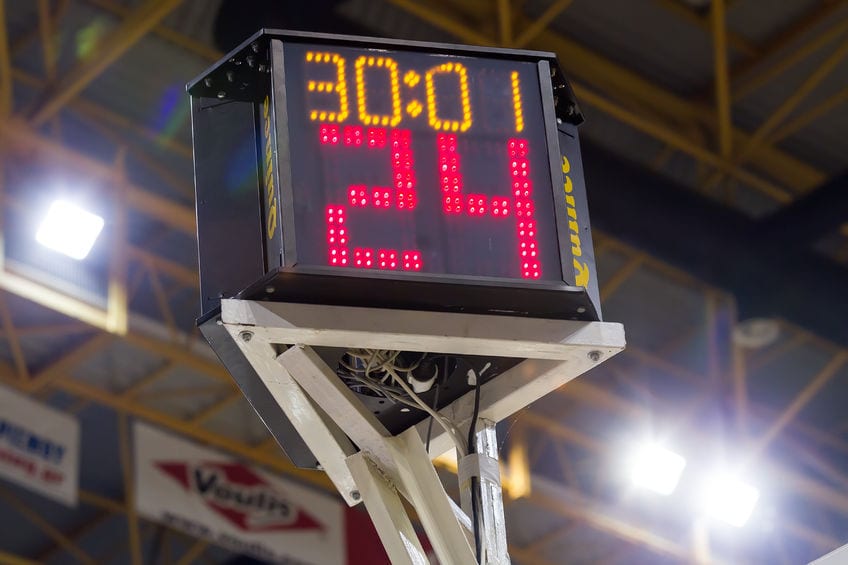BOCA RATON, FL – In a groundbreaking move which could foster improved patient flow across the country, Madre De Díos Clinic spokeswoman Chlöe Less announced that a shot clock buzzer was installed each patient exam room. “With this move aimed at streamlining the clinic experience, we hope that we can churn patients through and keep doctors on point.”
Gomerblog has learned the way the system works:
- After the patient is checked into the room by the medical assistant or nurse, the brightly lit panel affixed to the wall above the door is activated, with the time allotment dependent on whether the visit is a 20 minute or 40 minute slot.
- Once the shot clock is activated and it starts ticking down second by second, the physician/nurse practitioner/physician assistant assigned to see the patient gets a “moderate voltage” shock delivered to his or her groin via a “provider prod chastity belt” worn over the provider’s undergarment during each clinic day. This alerts the provider to quickly enter the patient exam room (since an additional shock is delivered every 60 seconds, each time with increasing voltage, until the prod device is detected in the room).
- Each provider is allotted 1 time-out per day (for bathroom or crying breaks & whatnot), and each patient gets one time-out per calendar year.
- As the clock reaches 2 minutes, an automated voice screams from the intercom on the shot clock “TWO MINUTES! TWOOOOOO MINUTES LEFT IN THIS APPOINTMENT!!!! ¡DOS MINUTOS!”
- When the shot clock expires, a loud buzzing sound is emitted from the intercom and the doctor’s provider prod chastity belt is reset, thereby abruptly terminating the clinic visit.
- If there is a dispute about whether a question was completed before the buzzer goes off, then the patient or the provider can throw the “challenge flag” in each room. If the flag gets thrown to the floor, Dr. Oz [located at a centralized “Healthcare Replay Center” in Secaucus, New Jersey] reviews the video & audio from the encounter & issues a verdict on the appropriate call.
- The provider prod chastity belt is deactivated from 12:50pm until 1:00pm for “lunch break,” though the provider is expected to have closed at least 50% of the morning’s charts by the end of this timeframe. So, basically, the provider has to chart during the lunch break.
- The provider continues to wear the provider prod chastity belt at home in the evening, because shocks are delivered on a q15 minute basis starting at 9pm until all charts for the day have been closed with billing submitted for all encounters.
- Any tampering with the prod chastity belt by the provider is a felony offense and also results in incremental deductions from the provider’s paychecks.
“This has been a nightmare,” said cardiologist Dr. Sri-Sheshadariprativadibayankaram. “My balls have been shocked so many times, I think they’re numb at this point.”
“So far the feedback from both the patients and providers has been positive!” reported clinic spokeswoman Chlöe Less. “Patients have long complained about their long waits for doctors, and providers have always whined about patients demanding extra time which throws off their entire schedule. I think healthcare administrator brain power has solved those problems! In fact, we are considering installing shot clock buzzers in our inpatient rooms at Madre De Díos Hospital for our clock-watching drug seekers who are constantly demanding their next dose of dilaudid too early. These are truly exciting times in medicine!”
Dr. Sri-Sheshadariprativadibayankaram, however, raises valid questions to Gomerblog. “I once had a patient who started to ask a very reasonable question before the shot clock buzzer went off, but didn’t finish the question until shortly after the buzzer had sounded. This triggered a review in the Replay Center, which ruled in my favor. But since I wasn’t able to respond to the question, the patient unfortunately began to experience a complication & was hospitalized the following day.”
When contacted by Gomerblog about Dr. Sri-Sheshadariprativadibayankaram’s concerns, Chlöe Less admitted “Well, there are always unintended consequences” and remarked that the doctor’s paycheck would be docked a penalty for the negative patient outcome metric.







